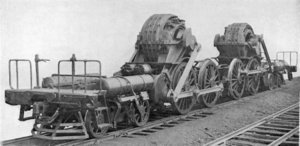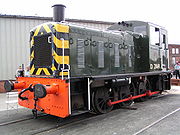
Jackshaft
Encyclopedia


Locomotive
A locomotive is a railway vehicle that provides the motive power for a train. The word originates from the Latin loco – "from a place", ablative of locus, "place" + Medieval Latin motivus, "causing motion", and is a shortened form of the term locomotive engine, first used in the early 19th...
. It is essentially an axle with no wheels. Each end of the jackshaft has a crank pin and a counterweight
Counterweight
A counterweight is an equivalent counterbalancing weight that balances a load.-Uses:A counterweight is often used in traction lifts , cranes and funfair rides...
. The driving wheels are then connected by side rods. The name may come from a combination of "jack," a slang
Slang
Slang is the use of informal words and expressions that are not considered standard in the speaker's language or dialect but are considered more acceptable when used socially. Slang is often to be found in areas of the lexicon that refer to things considered taboo...
term for a locomotive, and a rotating shaft.
Steam locomotives
Jackshafts were in use as early as 1836. The Stockton & Darlington's Swift used one to convert the vertical motion of its cylinders to rotating motion at the wheels.Jackshafts were also used on some small locomotives for a perceived savings of maintenance costs. Using the cylinders to drive a high-mounted jackshaft instead of connecting them directly to the wheels allowed the cylinders to be mounted higher up. This placed them above ground level dust. Whether the added complexity of the jackshaft was warranted is uncertain.
Several steam turbine locomotive
Steam turbine locomotive
A steam turbine locomotive is a steam locomotive which transmits steam power to the wheels via a steam turbine. Numerous attempts at this type of locomotive were made, mostly without success...
s used jackshafts to drive the wheels. The turbine was geared to the jackshaft, typically located at the front of the locomotive. This may have been done to help insulate the turbine from vibration of the wheels.
Electric locomotives
Some early electricElectric locomotive
An electric locomotive is a locomotive powered by electricity from overhead lines, a third rail or an on-board energy storage device...
locomotives were also equipped with jackshafts. Early electric locomotives required motors that were too big to fit near the axles. The motor turned the jackshaft either by gears or with a connecting rod, and then the jackshaft turned the wheels. Continuing development of electric motors made them smaller and made jackshafts obsolete. Examples include the PRR DD1
PRR DD1
The Pennsylvania Railroad's class DD1 were semi-permanently coupled pairs of third rail direct current electric locomotives built for the railroad's initial New York-area electrification. They operated between Manhattan Transfer and Pennsylvania Station in New York City, and from there to the...
and FF1
PRR FF1
The Pennsylvania Railroad's class FF1 was an American electric locomotive, a single prototype numbered #3931 and nicknamed "Big Liz" by its crews. It was built in 1917 for the task of hauling freight trains across the Allegheny Mountains, which the PRR planned to electrify; this was never...
electric locomotive
Electric locomotive
An electric locomotive is a locomotive powered by electricity from overhead lines, a third rail or an on-board energy storage device...
s.
Diesel locomotives
Some diesel locomotives used jackshafts as well. The British Rail Class 03British Rail Class 03
The British Rail Class 03 locomotive is, together with Class 04, one of BR's most successful smaller 0-6-0 diesel-mechanical shunters. The class, numbering 230 examples, was built by British Railways' Swindon and Doncaster works in 1957-1962 and numbered D2000-D2199 and D2370-D2399...
(pictured right) are examples. They were used on some diesel-mechanical and diesel-hydraulic locomotives but were seldom used on diesel-electrics. One exception was the British Rail Class D3/7
British Rail Class D3/7
British Railways Class D3/7 were diesel shunters built from May 1939 through to July 1942 by the London, Midland and Scottish Railway at their Derby Works. They were the first of a new design of diesel shunters based on the English Electric 6K diesel engine of .-Numbering:These were given LMS...
.
External links
- http://www.du.edu/~jcalvert/tech/machines/centro.htm
- http://www.australiansteam.com/sugar.htm
- http://www.rutlandherald.com/apps/pbcs.dll/article?AID=/20041031/NEWS/410310333/1031/FEATURES02
- http://www.aqpl43.dsl.pipex.com/MUSEUM/LOCOLOCO/locoloco.htm

